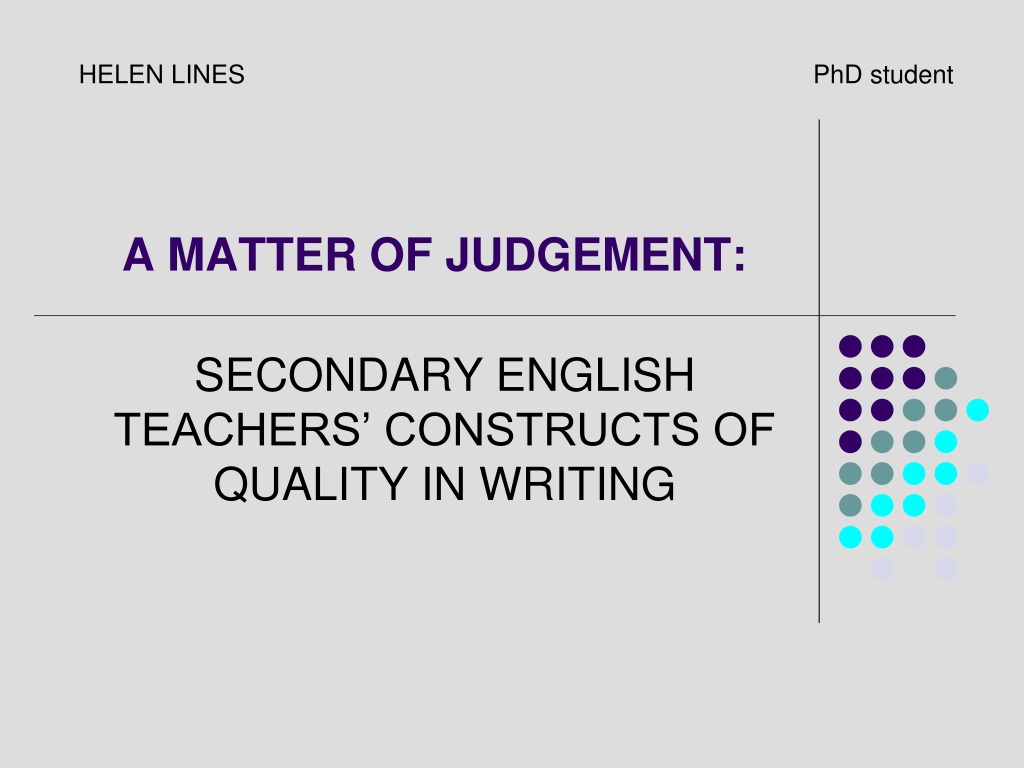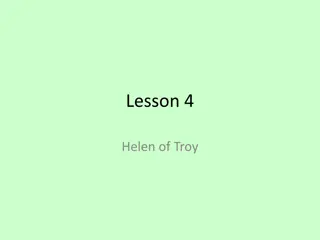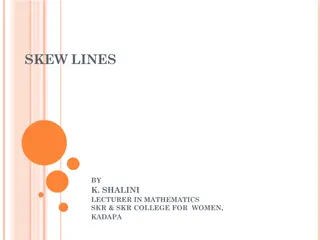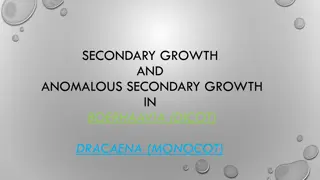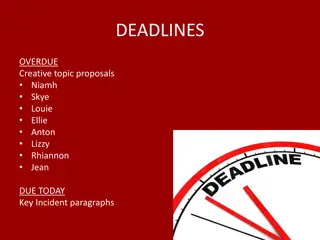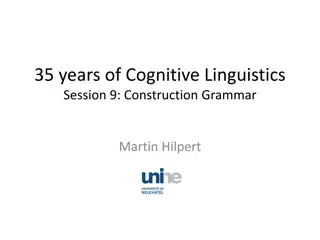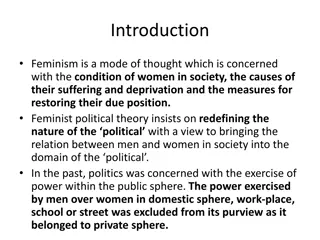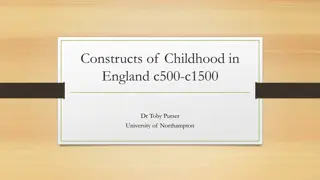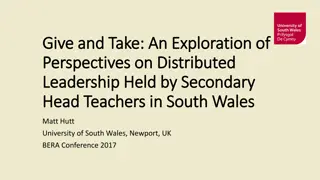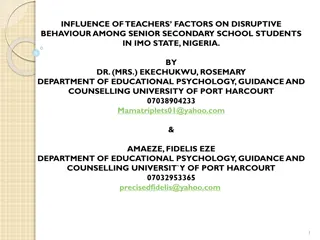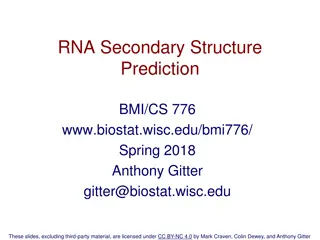Secondary English Teachers' Constructs of Quality in Writing: A Study by Helen Lines, PhD Student
This study by Helen Lines, a PhD student, delves into the constructs of quality in writing as perceived by secondary English teachers. Through analysis of data and exploration of teachers' definitions of writing quality, the research tackles the challenge of externalizing the concept of excellence for learners. By examining teachers' enacted constructs of quality in the classroom and their alignment with published assessment criteria, the study sheds light on the complex nature of assessing writing.
Download Presentation

Please find below an Image/Link to download the presentation.
The content on the website is provided AS IS for your information and personal use only. It may not be sold, licensed, or shared on other websites without obtaining consent from the author. Download presentation by click this link. If you encounter any issues during the download, it is possible that the publisher has removed the file from their server.
E N D
Presentation Transcript
HELEN LINES PhD student A MATTER OF JUDGEMENT: SECONDARY ENGLISH TEACHERS CONSTRUCTS OF QUALITY IN WRITING
Outline of presentation The research problem Analysis of data: teachers definitions of writing quality agreement and variation teachers different constructs of quality and their relationship with published assessment criteria teachers constructs of quality enacted in the writing classroom Implications and questions
The research problem How to draw the concept of excellence out of the heads of teachers, give it some external formulation, and make it available to the learner, is a non-trivial problem. (Sadler, 1989:127) A The writing classroom: a community of practice The writing classroom: a community of interpreters (Sharples, 1999) (Marshall & Wiliam (2006) S T
National assessment criteria: the gold standard for writing? It is hard to delineate precisely what makes a piece of writing good generically (Marshall, 2007:3) Exceptional performance Pupils writing is original, has shape and impact, shows control of a range of styles and maintains the interest of the reader throughout. Narratives use structure as well as vocabulary for a range of imaginative effects, and non-fiction is coherent, reasoned and persuasive, conveying complex perspectives. A variety of grammatical constructions and punctuation is used accurately, appropriately and with sensitivity. Paragraphs are well constructed and linked in order to clarify the organisation of the writing as a whole.
A qualitative study Sub-set of data drawn from a large-scale investigation into the impact of contextualised grammar teaching on students writing. Over the course of an academic year, 32 teachers of 12-13 year olds in two UK regions were observed teaching three writing genres: narrative fiction, argument and poetry. Follow-up interviews focused on pedagogic decisions and beliefs about teaching and assessing writing. Sample interview questions: What do you think makes good writing? What are you looking for as indicators of quality in writing? Do you think assessment criteria at Key Stage 3 and GCSE reward those qualities?
Teachers definitions of writing quality (in vivo coding) Teachers definitions of good writing echo national criteria. Has impact/maintains interest of the reader effective word choices (24) affects the reader (20) engaging (18) interesting (14) grabs your attention (9) shows writer s enthusiasm (7) enjoyable (6) memorable (3) believable (2) convincing (1) has immediacy (1) inspirational (1) exciting (1) pleases you (1) Is original shows originality (20) experiments (16) all about creativity (15) own voice comes through (13) shows imagination (8) shows flair (7) natural (5) spontaneous (2) adventurous (1)
Teachers definitions of writing quality (in vivo coding) Teachers definitions of good writing echo national criteria. Shows control confident (14) consciously crafted (13) sense of purpose and audience (11) sustained structure (11) control of sentence structure (11) shows effort (11) uses appropriate conventions (10) use of techniques (7) shows precision and control (4) choices can be justified (4) planned (3) done independently (1) Variety varied sentence structures (7) variety of techniques (6) variety of punctuation (3) varied vocabulary (3) Accurate technical accuracy (13) communicates clearly (10) fluent (5) competent (4)
Teachers judgements of writing quality A somewhat indeterminate process (Lumley, 2002:10) A dynamic process of drawing on and variously combining available indexes (Wyatt-Smith & Castleton, 2005:151) Teachers expect variation in judgement of writing quality. You re going to see thirty-two teachers and everyone is going to be completely different. (School 24) It s down to the individual marking so much of the time isn t it because what one person thinks is absolutely brilliant, someone else doesn t enjoy. (School 2) The longer I ve been in the job the more I realise how individual teachers assessment is so dramatically different for the same piece. (School 23) My expectations are different for every child, so a delightful piece from Joe who s a four minus is obviously completely different from what I would consider a delightful piece of work from Ellie who s a Level 7. (School 16)
Teachers judgements of writing quality Teachers have conflicting views about the nature and application of national assessment criteria. If you follow the mark scheme then it s going to inform your teaching because you know exactly what you are looking for and unless you know what you re looking for you can t teach the kids what the examiner is looking for or what good writing is all about. (School 12) I think you could argue for a piece of writing to be, you know, an A* or an A grade and that s what I don t like about it, that it s so open to that interpretation. (School 10) The fact that there was so little to describe what A* was, actually that pleased me more than anything else, that there s something sort of almost intangible. (School 23) I shouldn t be having to cheat my way round the criteria in order to get them recognition for very original, passionate, Catch-22-esque writing. (School 17)
Individual teachers have different dominant constructs of writing quality. It s a matter of personal taste (School 4) Good writing is: EMOTIONALLY ENGAGING (7) SELF-EXPRESSIVE (7) CONSCIOUSLY CRAFTED (7) FIT FOR PURPOSE (6) TECHNICALLY ACCURATE (4) INSTINCTIVE (4)
Summary of teachers constructs of quality Good writing is emotionally engaging These teachers primarily judge writing by its impact on the reader and the reaction it provokes Good writing is self-expressive These teachers primarily valuewriting that expresses the child s personal individual voice Good writing is consciously crafted These teachers reward writing that has been deliberately designed and that shows thought and effort Good writing is fit for purpose These teachers reward writing that is well matched to its audience and purpose and fulfils its function Good writing is technically accurate These teachers think accuracy, or the mechanics are an essential aspect of good writing Good writing is instinctive These teachers either think that quality in writing is too subjective or difficult to define, or that flair and originality can t be taught
Teachers different constructs of writing quality Good writing is: SELF-EXPRESSIVE (7) These teachers valued writing that showed the individual student s distinctive personal voice, often drawn from the child s personal experience. They valued writing that was unusual and different. They rewarded individual effort and judged progress against the individual s starting point. Good writing is the voice of a person isn t it, it s like you, it needs to be passionate, it s a person isn t it, it s like a person, good writing is you, and how much you enjoy words and putting them together because words are magic and words actually have so much power and if you have the ability to convey that through your writing and then I think it s all about empowerment and you ve won the world haven t you? (School 18)
Teachers different constructs of writing quality Good writing is: FIT FOR PURPOSE (6) These teachers valued writing that communicated its intentions clearly to the reader and used conventions appropriate to its form, audience and purpose. They rewarded students who tried out techniques they d been taught and who met specific targets. They valued writing that was assured and controlled but thought effective communication was more important than technical accuracy. Good writers think about the reader first it fulfils the purpose that it s there for, so if the purpose is to entertain or to inform or to persuade, it does that in a way that a reader understands fairly quickly it s about clarity of communication and whether or not it hits its purpose. (School 22)
For many teachers, there is a tension between their personal construct of writing quality and what they see as being rewarded by national assessment criteria. CLOSE MATCH 3 FIT FOR PURPOSE (2) SELF-EXPRESSIVE/TECHNICALLY ACCURATE (1) DEFINITE MISMATCH 14 EMOTIONALLY ENGAGING (5) SELF-EXPRESSIVE (5) INSTINCTIVE (2) CONSCIOUSLY CRAFTED (2) Criteria describe essential skills and qualities but are too prescriptive (5) Depends on key stage and exam board (4) Criteria guide judgements but there should be more room for professional instinct (2) Too inexperienced to trust judgements (2) Unsure how far accuracy should count (1) AMBIVALENT 14
For many teachers, there is a tension between their personal construct of writing quality and what they see as being rewarded by national assessment criteria. Construct: Good writing is emotionally engaging These teachers valued writing that had an emotional impact on the reader and to which they could relate strongly, often expressing this through metaphor and analogy, e.g: it excites and moves you; it knocks your socks off; makes the hairs on the back of your neck stand up. They valued writing that was engaging and entertaining, imaginative and creative. Typical responses to national assessment criteria Criteria encourage explicit teaching and give students tools for improving writing but can be too rigid, prescriptive and reductive: too much emphasis on accuracy and tick boxes; writing by rote; following a recipe. Writing should be judged holistically. Assessment drives teaching too much. Tasks can restrict and deaden writers and are unnatural.
For many teachers, there is a tension between their personal construct of writing quality and what they see as being rewarded by national assessment criteria. Construct: Good writing is consciously crafted These teachers valued writing that had been deliberately designed and crafted and that demonstrated conscious control and effort: writing has thought and deliberation behind it. The process of writing was often more important than the product. They rewarded students who took risks and experimented even if they don t quite get it right. They thought it was important for students to explain and justify writing choices, seeing this as a life skill. Typical responses to national assessment criteria Criteria don t always encourage or reward inventiveness and experimentation but force teaching of formulaicstructures. Pressure of exams leads to spoonfeeding. At both key stages, there needs to be more attention to explicit teaching of techniques not just getting through content. Qualities of originality and flair should not just apply to the highest grades. Teachers should be able to reward individual effort and tailor criteria to match the child.
Constructs in the classroom Teachers personal constructs of writing quality may influence classroom discourse about writing School 4 Teacher values: writing that provokes a strong emotional reaction in the reader personal creativity (writes herself) powerful choice of words and ideas that move and excite the reader Responses to assessment criteria: recognises subjectivity of different readers responses thinks too much weighting given to accuracy over creativity (real writers have editors and proofreaders) explicitly teaches to exam criteria (e.g. sentence variety) but is ambivalent about providing a formula In the writing classroom: clear expectation of student participation - emphasis on trying things out motivates through own enthusiasm; shares own writing and personal examples adapts project lesson plans to suit own teaching style - building in time for discussion and reflection of students own writing; encourages them to be critical friends strong emphasis on evaluating effects of word choices on the reader - actively promotes thinking about choices and meaning
Constructs in the classroom Teachers personal constructs of writing quality may influence classroom discourse about writing School 15 Teacher values: writing that communicates clearly to the reader clever use of techniques reader-writer relationship thinks writing should be viewed from perspective of how well it fulfils its purpose for the reader Responses to assessment criteria: they encourage students to focus on audience and purpose and on what makes a good piece of writing there is a strong continuity between the key stages in terms of what is valued exam tasks don t always allow students to show what they can do In the writing classroom: explicitly positions students as real readers of texts, both published and their own: what matters is how you respond to the writing; I m interested in your reactions to these charity adverts gives very clear explanations of the purpose of reading and writing tasks: to help you see what persuasive techniques are used to get you to part with your money; to make a judgement about which viewpoint is most effective doesn t over-direct their responses they often feed back to each other and redraft in light of peer response
Implications and questions Does variation matter? Not advocating that every classroom should be the same, nor that one construct is better than another. But what are the implications for practice of: differences between teachers in how they view quality and share those views with students? tensions between teachers personal constructs of quality and national assessment criteria? How conscious are teachers of their own constructs? How can this be investigated?
References Lumley, T. (2002) Assessment criteria in a large-scale writing test: what do they really mean to the raters? Language Testing,19, 246-276. Marshall, B. (2007) Assessment in English. In Handbook of Primary English in Initial Teacher Education, Cremin, T. &Dombey, H.(eds.). Marshall, B. & Wiliam, D. (2006) English inside the black box: Assessment for learning in the English classroom. London: King s College Sadler, R. (1989) Formative assessment and the design of instructional systems. Instructional Science, 18 (2), 119-144. Sharples, M. (1999) How we write: writing as creative design. London: Routledge Wyatt-Smith, C. & Castleton, G. (2005) Examining how teachers judge student writing: an Australian case study. Journal of Curriculum Studies, 37 (2), 131 154.
